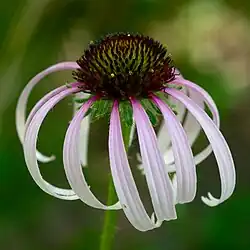Echinacea sanguinea
| Echinacea sanguinea | |
|---|---|

| |
| Scientific classification | |
| Kingdom: | Plantae |
| Clade: | Tracheophytes |
| Clade: | Angiosperms |
| Clade: | Eudicots |
| Clade: | Asterids |
| Order: | Asterales |
| Family: | Asteraceae |
| Tribe: | Heliantheae |
| Genus: | Echinacea |
| Species: | E. sanguinea
|
| Binomial name | |
| Echinacea sanguinea | |
| Synonyms[1] | |
| |
Echinacea sanguinea, the sanguine purple coneflower, is a herbaceous perennial native to open sandy fields, open pine woods, and prairies in eastern Texas, southeastern Oklahoma, Louisiana, and southwestern Arkansas.[1][2][3] It is the southernmost Echinacea species.[4] The specific epithet sanguinea, which is Latin for "blood", refers to the color of the petals.
Description
It grows up to 120 cm (4 ft) tall with an unbranched stem.[3] The alternate leaves are typically close to the ground, growing 10–25 cm (4–10 in) long and 6 mm (¼ in) wide, with the upper leaves having long hairs.[3]
It flowers from late spring to early summer at low altitudes 0–200 m (0–656 ft).[3] Each stem has one rose-pink to pale purple flower head, up to 5 cm (2 in) long and 12 mm (½ in) wide, with 10–20 ray flowers that conspicuously droop.[3] The 2.5 cm (1 in) cone-shaped center containing the disc florets is purplish-brown on the outside and greenish toward the center.[5]
References
- ^ a b "Echinacea sanguinea Nutt". USDA Natural Resources Conservation Service. 2014. Retrieved 30 July 2025.
- ^ Biota of North America Program 2014 county distribution map
- ^ a b c d e "Echinacea sanguinea". Flora of North America. 5 November 2020. Retrieved 30 July 2025.
- ^ Gladstar, Rosemary; Pamela Hirsch (2000). Planting the Future. Bear & Company. p. 96. ISBN 978-0-89281-894-5.
- ^ Loughmiller, Lynn; Lynn Sherrod (1984). Texas Wildflowers. University of Texas Press. p. 55. ISBN 978-0-292-78060-6.